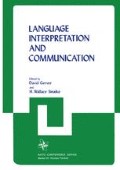Abstract
The nonbalanced bilingual is much more typical of the present world than the balanced one. This is however by far not evident at first sight. The apparent balance of a bilingual’s language systems is often due to strategies and compensatory processes which he has learned to employ when using his subordinate language. If his pronunciation is good and his lexicon reasonable, a mere simplification of speech will hide his slower functioning in the weaker language, less automaticity as well as inferiority in grammar and syntax. These shortcomings may well remain hidden until some stress is added. Information overload, environmental, emotional or social stresses, fatigue, all these factors may unveil the hidden imbalance between the dominant and subordinate languages. Stress enhances latent differences and renders them apparent: language dominance which under normal circumstances would not appear becomes evident under stress.
Access this chapter
Tax calculation will be finalised at checkout
Purchases are for personal use only
Preview
Unable to display preview. Download preview PDF.
References
Dornic, S., Verbal factor in number perception. Acta Psychologica, 1969, 29, 393–399.
Dornic, S., Deneberg, C. B., and Hágglund, M. La exploración visual cuando se emplea una lengua dominante o no dominante. (Visual search in dominant and nondominant languages). Revista de psicología general y aplicada, 1975, 30, 1123–1134.
Ervin, S. M. Learning and recall in bilinguals. American Journal of Psychology, 1961, 74, 446–451.
Gerver, D. Empirical studies of simultaneous interpretation: a review and a model. In R. W. Brislin., (Ed.)., Translation: Applications and research, New York: Gardner Press, 1976.
Gutierrez-Marsh, L., and Hippie Maki, R. Efficiency of arithmetic operations in bilinguals as a function of language. Memory and Cognition, 1976, 4, 459–464.
Hamers, J. F., and Lambert, W. E. Bilingual interdependencies in auditory perception. Journal of Verbal Learning and Verbal Behavior, 1972, 11, 303–310.
Kolers, P. A. Reading and talking bilingually. American Journal of Psychology, 1966, 79, 357–376.
Lambert, W. E. Measurement of the linguistic dominance in bilinguals. Journal of Abnormal and Social Psychology 1955, 50, 197–200.
Lambert, W. E., Havelka, J., and Gardner, R. C., Linguistic manifestations of bilingualism. American Journal of Psychology, 1959, 72, 77–82.
Macnamara, J. The bilingual’s linguistic performance — A psychological overview. Journal of Social Issues, 1967a, 23, 58–77.
Macnamara, J. The effect of instruction in a weaker language. Journal of Social Issues, 1967b, 23, 121–135.
Macnamara, J., Krauthammer, M., and Bolgar, M. Language switching in bilinguals as a function of stimulus and response uncertainty. Journal of Experimental Psychology, 1968, 78, 208–215.
Preston, M. S., and Lambert, W. E. Interlingual interference in a bilingual version of the Stroop color-word task. Journal of Verbal Learning and Verbal Behavior, 1969, 8, 259–301.
Rao, R. S. Development and use of Directions Test for measuring degree of bilingualism. Journal of Psychological Researches, 1964, 8, 114–119.
Scherer, G. A. C., and Wertheimer, M. A psycholinguistic experiment in foreign- language teaching. New York: McGraw-Hill, 1964.
Uchtomski, A. A. Sobranie sotchinenii. Leningrad, 1945.
Author information
Authors and Affiliations
Editor information
Editors and Affiliations
Rights and permissions
Copyright information
© 1978 Plenum Press, New York
About this chapter
Cite this chapter
Dornic, S. (1978). The Bilingual’s Performance: Language Dominance, Stress, and Individual Differences. In: Gerver, D., Sinaiko, H.W. (eds) Language Interpretation and Communication. NATO Conference Series, vol 6. Springer, Boston, MA. https://doi.org/10.1007/978-1-4615-9077-4_23
Download citation
DOI: https://doi.org/10.1007/978-1-4615-9077-4_23
Publisher Name: Springer, Boston, MA
Print ISBN: 978-1-4615-9079-8
Online ISBN: 978-1-4615-9077-4
eBook Packages: Springer Book Archive

